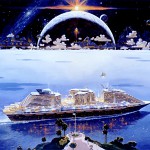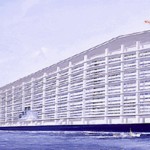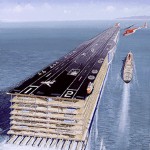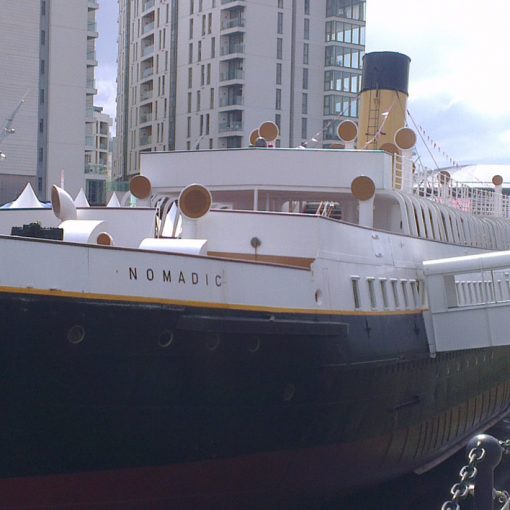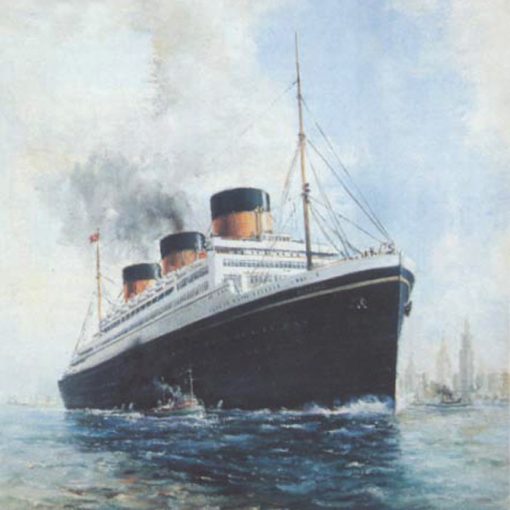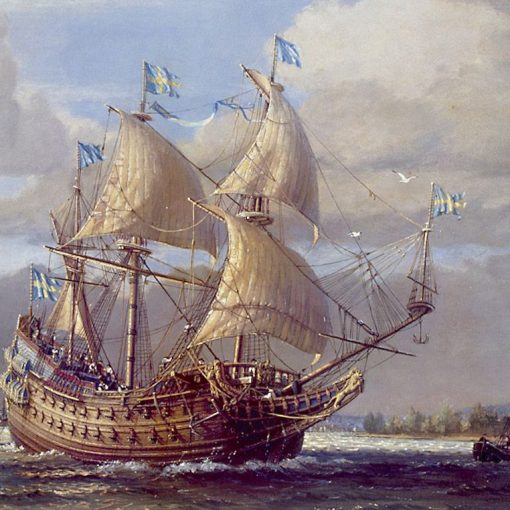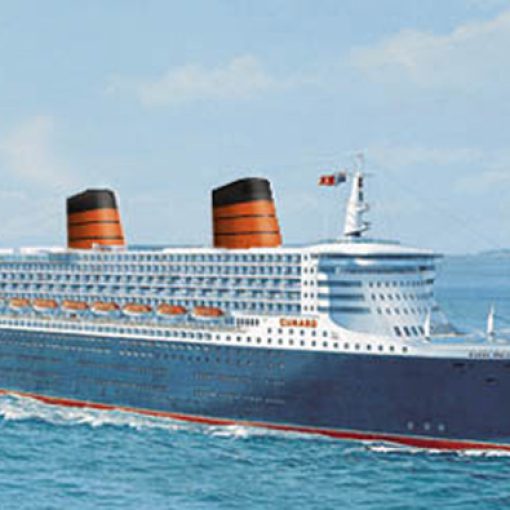Note: this text was originally written in 2001. Neither of the two projects covered have come to fruition, and their respective websites have gone belly-up. While this is not much of a surprise, we have kept this article on the site nevertheless, since it is an interesting reflection of where (and how) we were as ship enthusiasts at the time.
When it comes to ships, who can tell what the future has in store? During the last two decades of the 20th century, we saw cruise ships developing at a rapid pace. In 1997, the Queen Elizabeth was finally surpassed as the largest passenger ship ever, with the arrival of Carnival’s Destiny. The future will undoubtedly bring more fantastic ships, but there are a few projects on the drawing boards that perhaps should not be labelled ‘ships’, but ‘floating cities’.
The arrival of Carnival’s 101,000 gross ton Destiny in 1997 marked a very special event. Not only was she the first passenger ship to exceed 100,000 tons, but this was also the first time that a cruise ship surpassed the liners of old in size. Since the Destiny, more giant cruise ships have entered service, the 109,000-ton Grand Princess and, of course, the 137,000-ton Voyager of the Seas. One might ask oneself where this will end, if it ever will. Some ship experts and historians believes that the great era of the ocean liner may just have begun, instead of ended 40 years ago with the advent of the long distance airliner.
True, ships today are not what ships were in the old days when the North Atlantic was the arena of fierce competition. No longer are they used to transport emigrants to new countries, and no longer are they used as mere means of transportation. Nowadays, the ship is many times a destination in itself, offering large shopping streaks and glittering, Las Vegas-inspired shows, while cruising in warm waters and making stopovers at paradise islands. The modern ocean traveller is in search of one thing: recreation. And the cruise ship companies are building ships to give them just that.
The future might see giant ocean-going vessels unlike anything the world has seen so far. There are people who are dreaming of massive floating cities that will dwarf even the Voyager of the Seas.
Knut Kloster, the man who in 1979 bought the derelict superliner France and turned her into the world’s largest cruise ship, is now dreaming of a new ship; the America World City. This ship would be more than twice the size of Grand Princess by measuring some 250,000 gross tons. At 1,250 feet in length and nearly 300 feet wide she would surely be an impressing sight.
A floating city, with three giant towers placed upon a massive hull, the America World City would offer her passengers amenities such as a 2,000-seat theatre, a 100,000-book library, an art gallery, a 2,800 hotel room capacity and a complete American main street, filled to the brim with shops and boutiques. Furthermore, the ship will offer 100,000 square feet of dedicated meeting and conference space and a stock brokerage office for business.
The America World City is intended as the first of three such ships, which will all sail in US territorial waters. One on the west coast, one on the east coast and one in Hawaiian waters. Drawing just approximately 33 feet of water, the ships will be able to visit most major ports. But where such visits is impossible, her passengers will be carried ashore by her four 400-seat day cruisers. These will be located in the stern part of the hull, which will contain a complete marina within its closed doors.
A great dream indeed, but no matter how impressive 250,000 gross tons may sound, it is not much compared to Norman L. Nixon’s project – the Freedom. With a length of 4,320 feet, a beam of 725 feet and a height of 340 feet, such a ship would probably be the longest that will ever be constructed. Displacing 2,700,000 tons of water – compared to the largest tankers of today which displaces some 500,000 tons – this would probably be the ultimate floating city.
The question is if this is at all to be called a ship, as much as a giant floating real estate. According to Nixon, Freedom will be large enough to bring on more than 50,000 residents, 15,000 employees, 20,000 day guests and still have four times as much roaming-around square footage per person as the most modern cruise liners. The size of the Freedom will be so large that it will have to be built in sections, which will then be assembled at sea. Naturally, no port will be able to handle such a creation. This is no problem, as the top of the ship houses a complete airstrip, capable of handling private jets and smaller commercial planes.
The Freedom will indeed be a community on its own. Because of its vast size, she will be equipped with her own railway system. All that is needed for a year-round stay will be there, from movie theatres and a stock exchange to grocery stores and educational facilities.
Because of her size, the Freedom will not resemble any ship ever built. Unlike the America World City, the Freedom will not have a traditional hull. Instead, the base of the ship will consist of over 600 individual airtight cells. These cells will be the foundation of the rest of the ship, which is more or less just an enormous superstructure with an airport on top. As with the America World City, there will be a marina at the stern, making it possible for the wealthy residents to do daily excursions from the Freedom with their own private yachts.
If these plans will ever come to fruition is of course impossible to say. Those who were sceptical when Kloster announced the America World City are probably laughing at Nixon and his dream of the Freedom. It’s true that these projects – especially the Freedom – might seem as crazy dreams that will never come to be. But no one can tell. The history of shipping has presented surprises in the past, and it is not at all unlikely that a few more will come in the following years.
Going back in time, one finds examples of men who were laughed at when they tried to make their dreams come true. Take Isambard Kingdom Brunel for example. Not many believed in him when he constructed his 18,000-ton Great Eastern – a veritable mammoth in her days. When Knut Kloster turned the France into the Norway, most people thought that it would be financial suicide. So, all we can do is wait and see what the future has in store. Perhaps there will come a time when the America World City is thought of as a small ship…

